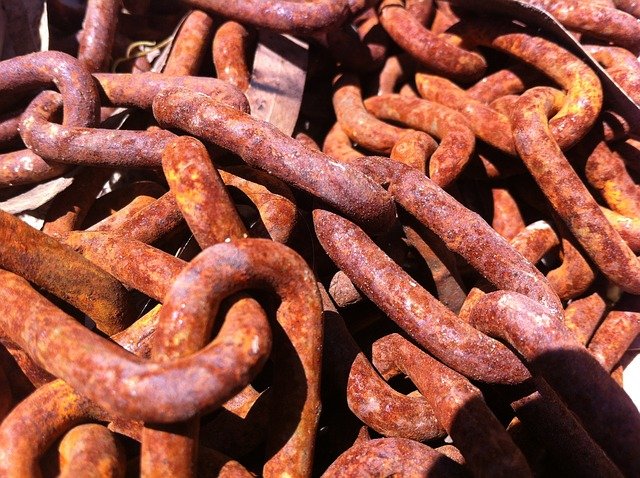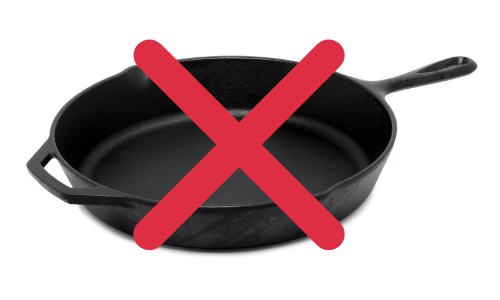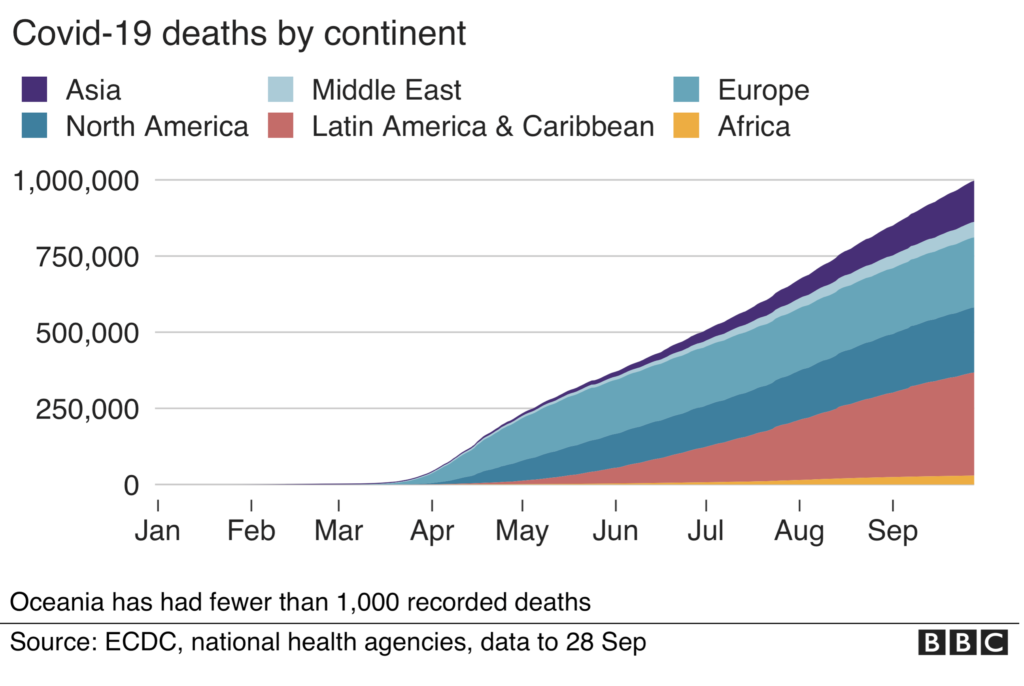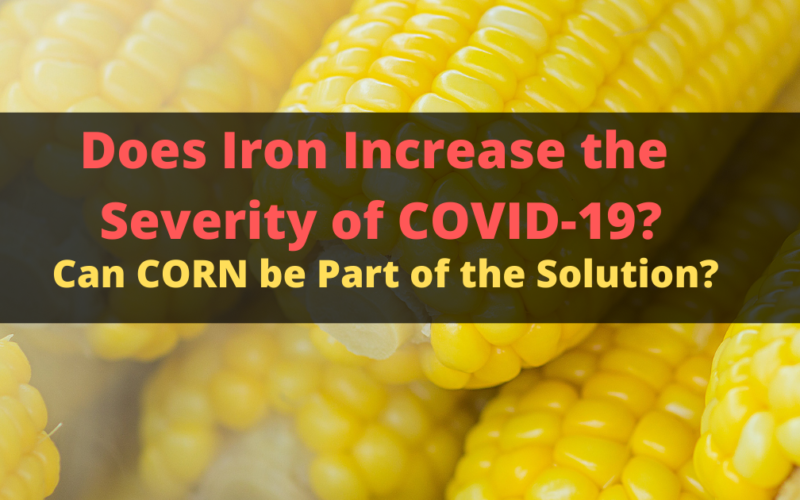
By Rita Wilhelm
Why does Africa have the lowest death rate from COVID-19 in the world?
Why is the death rate so much higher in Europe?
Why are older people more at risk than younger people, and men more so than women?
I’m a nutritionist and a researcher, and have spent many thousands of hours studying insulin resistance, which is a precursor to many chronic diseases such as diabetes, cardiovascular heart disease, Alzheimer’s, and more. In my research, I have found that COVID-19 has many of the same underlying conditions. In this 2-part article, I’m going to make the case that severe COVID-19 cases are due to iron overload, and that corn (also known as maize) could potentially lower the severity risk of a SARS-CoV-2 infection.
But first … my disclaimer: I am not a doctor. I’m not diagnosing or treating any diseases or condition. I’m simply sharing what I have learned, and this is my take on the situation.
Before discussing COVID-19, I want to share what I believe is the underlying cause of diabetes, and why this is related. In a nutshell, I believe that diabetes is caused by a combination of stored iron, which in turn creates an ideal environment for gram-negative bacteria to grow, and when these bacteria die, they release a toxin that enters our bloodstream either through a leaky gut, or during saturated fat absorption. You can read more about my research on diabetes here.
Once I starting digging in deep into COVID-19, I began to realize that the conditions were very much the same as those with diabetes. I have to say I felt validated when I read that the American Society of Microbiology, put out a very similar theory.
COVID-19, like type 2 diabetes and other chronic diseases, have high iron stores in common. This iron might be stored in a blood protein called ferritin, but it can also be stored in joints, the liver, the pancreas, the spleen, the heart, the brain, the skin, in fat, and in plaques among other places. It’s already been known since 1886 that diabetics had abnormal deposits of iron in their organs. ( R , R )
Iron in the liver causes cirrhosis, iron in the pancreas causes diabetes, iron in the skin causes orange coloring (bronze diabetes), iron in the thyroid causes hypothyroid, iron in the brain may cause Alzheimer’s, and this list goes on. ( R, R ) Cancer may be due to high iron as well. ( R , R )
One of the main problems with iron is that the body has no natural pathway to get rid of excess iron. When we are young, we don’t have much stored iron yet, but as we age, iron accumulates. This could be why the elderly are more vulnerable when it comes to COVID-19, and why young people have less symptoms. Men are also more at risk for COVID-19.( R ) This may be because men typically have higher iron stores than women, due to the fact that women lose iron during menstruation. ( R )
Stored iron causes oxidative damage and free radicals ( R ) You can see this in how iron corrodes and begins to rust when it reacts with water and oxygen.

But oxidative damage isn’t the only problem caused by stored iron.
Bad bacteria and viruses need iron to replicate. The body in its enate wisdom knows this, and will remove iron from the bloodstream and place it into storage, with specialized cells protecting these stores. The body may be using vitamin D to make anti-microbial and anti-viral molecules that help to keep iron stores away from these microbes and viruses. In fact, it could be that plaques, such as amyloid plaque seen in Alzheimer’s, is formed for this very reason. This could be one of the reasons why a person’s iron and vitamin D status are so closely connected. ( R, R, R, R, R, R )
This could also be why we see very deficient levels of vitamin D in severe COVID cases. ( R ) It’s basically a response to infection. ( R )
New research is also showing that people with a severe COVID-19 infection have low levels of interferon, which is a molecule that the body creates to fight viruses. Interferon “interferes” with viral replication. ( R )
A high iron diet has been found to reduce interferon levels. Researcher have found that in other viruses, patients do not respond to interferon therapy until after iron stores have been depleted through phlebotomies, which is much like a blood donation. ( R )
But bad bacteria and viruses have developed methods to combat our immune response. Pathogenic bacteria have been found to be able to control and turn on viruses as a way to cause stress in the host (us). This is because when we are stressed out, we release a stress hormone called epinephrine. When this hormone is available, it creates a portal of sorts, for bacteria to access those iron stores. ( R )
If an infection persists, a person can become anemic, as iron will be continually be pulled out of the blood stream to keep it away from the invading pathogen. This is when we get what is called Anemia of Inflammation, also known as Anemia of Chronic Disease. ( R )
This Anemia of Inflammation is what is being seen with severe COVID-19 cases, and this can lead to hypoxia. ( R )
And as we have all heard, hypoxia is a common symptom of COVID-19. Hypoxia is actually a method the body uses to help produce red blood cells from stored iron, when there is no longer enough available iron left to make red blood cells. ( R )
Another thing you may have heard about in the news, is that someone with an O blood type has a reduced risk of infection. (R) Interestingly, those with an O blood type naturally carry less iron in their blood and are for the most part resistant to anemia. (R)
It would seem that a person with high iron stores might experience more of an infection than others.
And sadly that is what is seen with COVID-19. It’s been shown that those with high iron stores had a poor prognosis of survival. Because of this, researchers are looking at adding iron chelators (a molecule that binds to iron and helps to remove stored iron) as a strategy in treating COVID-19. ( R, R, R )
So, when people take iron supplements due to what they think is an iron deficiency, they may actually be adding fuel to the fire by providing more iron to the pathogen that may be causing their issue in the first place. And, this can ultimately increase the amount of iron that sits in storage. (See my research article: You Better Think Twice about that Iron Supplement).
But how does one get too much iron in the first place?
Supplementing with iron is one cause, but genetics, foods fortified with iron, and cooking in or on a cast iron skillet or grill, will all put a person at risk. Let me explain.
People with hereditary hemochromatosis absorb much more iron than those who don’t have this gene. And, people with hereditary hemochromatosis are more susceptible to bacterial and viral infections. The CDC also states on their website that people with hemochromatosis are more likely to have a severe COVID-19 infection, than those who don’t. ( R, R )
I believe this can be seen in the very high COVID-19 death rates we see in Northern Europe, Spain and Italy, where this gene is common. ( R ) Based on statistics from Worldometer from October 8, 2020, and calculating total deaths divided by total cases, Ireland had a 4.5% death rate, Sweden 6.0%, the Netherlands 4.2%, Belgium 7.3%, Italy 10.7%, Spain 4.6% and Germany 3.5%.
And yes, I realize that using these statistics isn’t a perfect measuring tool, but it’s the best we’ve got for analysis right now. Those figures may actually be on the low side, as October 8, 2020 also happened to be the highest recorded date of new infections in Europe ( R ) , which may mean that these are people infected in the early stages of the disease. And, it does not include people who are currently in critical condition.
Interestingly, this gene is also common in Norway and Denmark. Yet, Norway has a 2.0% death rate, and Denmark has a 2.4% death rate. Why is that?
Norway and Denmark realized years ago, that iron-fortified foods caused health hazards in their population. Norway outright bans iron-fortified foods on their shelves. Denmark tried to do the same and banned Kellogg’s fortified cereals saying that the amounts were in ‘toxic doses’ and could damage the health of children and pregnant women. But due to pressure from the EU, they now allow it, so instead, they make it very difficult for retailers to put iron-fortified foods on the shelf. ( R, R )
Working to keep iron-fortified foods away from their citizens is probably why Norway and Denmark have relatively low death rates.
The concept of iron fortification started in the 1950’s, initially as a marketing gimmick to offer people an enhanced product. Eventually, countries got on the bandwagon as well, and started to mandate that flours be fortified with iron. This was probably because health workers were seeing low blood iron in various populations. Unfortunately, the ‘acute phase reaction’ with blood iron going low in response to an infection, was probably not well understood at that time. Low blood iron doesn’t mean iron stores are low.
According to a 2016 analysis, 85 countries mandate that either corn, wheat, or rice are fortified with iron during processing. ( R )
Other countries iron-fortify condiments. China for example, with a 5.4% death rate, fortifies soy sauce with iron.
On top of all the iron-fortification that is happening in staple foods around the world, many food manufacturers add even more iron to the final product. Breakfast cereal companies for instance, such as Kellogg’s and Post, add iron shavings to their breakfast cereals. Just search YouTube, and you will see plenty of experiments showing how people can pull out these iron shavings from a breakfast cereal using magnets.
Many iron-fortified breakfast cereals contain even more iron than what is shown on the label. A 2003 study that analyzed iron intake among German children and adolescents found that there was 120-150% more iron added to these already iron-fortified cereals, than what was stated on the label. The authors concluded that the daily consumption of breakfast cereals may contribute to excessive intakes of iron.
I have to ask myself, in Western culture where iron is plentiful, why would we continue to iron-fortify foods when iron overload is a very real thing? Perhaps that is really what is wrong with the Western diet.

Cooking methods can also cause iron overload. Cast iron cooking can leach a significant amount of iron into food. According to the American Dietetic Association, cooking spaghetti sauce in an iron pan can increase the iron content of the sauce by 945%, from .61 to 5.77mg/100g. Using a cast iron skillet for cornbread, has been shown to increase the iron content of cornbread by 28%, from .67 to .86mg/100g. ( R )
It’s also interesting to note that cooking in cast iron is something that started in the 1700s, but didn’t become mainstream until around 1865, when kitchen stoves became common. This also happens to be about the time when doctors started to notice people’s skin starting to bronze, which eventually became known as “bronze diabetes”, which they connected to iron overload. ( R )
The average adult in Mexico eats 10-12 tortillas per day, made from mandatory iron-fortified corn or wheat flour and cooked on iron comals, which are much like an iron skillet. Historically, these comals were made of clay, but now cast iron comals are more common, especially in urban areas. Add to the fact that many people in Mexico also have a genetic susceptibility to load iron, it’s no wonder their death rate is high at 10.3%.
So why could Africa’s COVID-19 death rate be so low?
Experts have been puzzled as to why the COVID-19 spread and death rate in Africa remains relatively low, especially since they have the 2nd largest population behind Asia.( R ) Nigeria has a 1.9% death rate, Ethiopia a 1.5%, Uganda 1.0%, South Africa 2.5%, Congo 2.6%, Zimbabwe 2.9%, Libya 1.6%, Kenya 1.9% and Rwanda with just .6%.

Although many of these African countries have iron-fortification legislation ( R ), the fact is that most of their flours are not being industrially processed, so most people are not eating iron-fortified foods. (South Africa is a little different, and I’ll tell you more about that in Part-2 of this article.) Rwanda has only been fortifying with iron since 2019, which means that their population hasn’t had the iron build-up potential that can be seen in countries that have had mandatory legislation for many years.
It’s probably a good thing that much of Africa is not eating fortified food, and not commonly cooking on cast iron, as people of African descent also have a gene that affects iron metabolism. This has been called African Iron Overload, and also known as Bantu siderosis. It first discovered when a community in Africa started to make home-made beer in iron barrels, which increased the iron levels in beer. People that drank this beer started to get iron overload symptoms.
And this could be why African Americans are more prone to a COVID-19 infection. Genetically, they may be more susceptible to iron overload from fortified foods and cast-iron cooking. A 1997 study found that Nigerians living in Nigeria has a diabetes prevalence of 2%, while Nigerians living in the UK has an 11% prevalence. ( R )
But not everyone in Africa has low death rates. Egypt is high at 5.6% and Sudan is at 6.2%. What is going on there?
In 2008 the Government of Egypt implemented a 5-year national program to iron-fortify wheat used to make Baladi bread, which is a subsidized staple food for low-income people. About 80% of Egyptian people consume Baladi bread ( R ). Additionally, cast iron cooking is common in Egypt among the older generations.
In Sudan, 90% of wheat, the primary cereal grain, is fortified with iron. A study on pregnant Sudanese women found that iron overload was a problem. ( R ) They are also finding that iron overload is behind many of the chronic diseases in Sudan. ( R )
In India we also see a lower death rate, ate 1.5%. Iron fortification in India is voluntary, with most flour free of fortification. However, within middle and upper-income populations, people generally cook their flatbread, ‘parantha’ or ‘chapati’, on a cast iron pan called a ‘Thava’. Luckily, they also typically drink tea with their parantha, which reduces iron absorption from meals. ( R )
So what’s the solution? What can we do to normalize iron levels?
We need to develop more beneficial bacteria in our gut to help us win the fight. It is going to have to involve a microbial change, as we’ve got to stop the body from wanting to keep iron away from microbes and bacteria. ( R )
We’ve also got to make sure we have nutrients like copper, which is essential in normalizing iron and fighting infection. You can read my research on copper here.
Vitamin A, and certain carotenoids (a chemical found in plant food that gives certain foods it’s orange or yellow pigment) are also important nutrients in the acute phase reaction and in iron metabolism.
I believe that corn (unfortified), that is not cooked using cast iron, could be the superfood we are looking for when it comes to reducing our COVID-19 risk.
Read Part 2: Why Corn?

